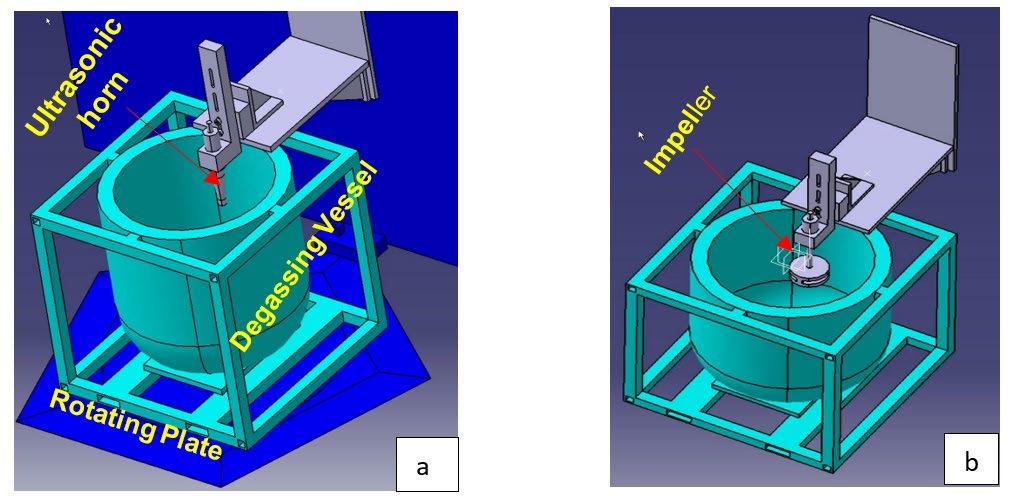
9 minute read
R. Haghayeghi.................................................................................................................................... pag
An investigation on effect of rotary degassing-ultrasonic method on high pressure die casting products
R. Haghayeghi
A new rotary degassing-ultrasound system was implemented and compared with Impeller+N2. The results suggest an enhanced hydrogen removal from the melt with a one third of required time for degassing by Impeller+N2. The gas removal increased by 20% in comparison with rotary impeller. Inclusions reduced significantly by 3 and 6 times compared to impeller+N2 and non-treated melt, respectively. Better cavitation dispersion, increased bubble surface area, less dross formation and better floatation rate contributed to better degassing and inclusion removal. For the first time, the ultrasonic melt treatment was performed on 400 Kg melt whereas the maximum volume ever been treated was 200 Kg.
INTRODUCTION Al-Si-Cu alloys are appropriate candidates for automotive applications. Many components such as ladder frame or engine block are produced from this group of aluminum alloys. A major problem in these alloys is porosity formation. This is related to various factors like the obstruction of feeding channels by β-Al5FeSi phase as well as the segregation of copper by formation of constitutional undercooling ahead of the eutectic/liquid interface and establishment of eutectic mushy zone [1]. In addition, intermetallic compounds precipitate at last stages of solidification, that is when feeding is critical and permeability is the lowest [1]. This further could contribute to porosity formation. Alloying elements would have an effect on porosity formation. Previous researches [1-3] have shown the deleterious effect of Fe-Cu interaction on increasing the porosity content in Al-Si-Cu alloys. Hence, finding a solution to the above is required. In this research, the effect of rotary degassing ultrasonic process in a large pool of melt respecting previous researches [4,5] has been analyzed. It was compared with impeller degassing and its effects on porosity formation in a high pressure die casting (HPDC) process were discussed.
Experiment About 400 kg of molten metal of Al-9 wt.%Si-3 wt.%Cu-1.3 R. Haghayeghi
Volvo Truck North America, 13302 Pennsylvania Avenue, Hagerstown, MD 21742, USA
wt.%Fe (TLIQUIDUS=620 oC) melted in an electrical furnace. It was transferred to degassing vessel at 700±5 oC. Two separate processes were implemented to degas the melt, namely a rotary furnace-sonication system and an impeller degassing where N2 was blown from the bottom of the impeller (Figure 1). The sonication was applied by an air-cooled piezoelectric transducer at frequency of 25 kHz, amplitude vibration of 25 μm and an input power of 1 KW for 3 minutes. Simultaneously, the vessel was rotating (2 rpm) with a circular plate underneath where the ultrasonic horn was located at 2/3 of the radius of degassing tank (Figure 1a). This position was determined based on preliminary experiments which have evidenced how the sonotrode’s position affects the acoustic streaming and the grain morphology of the solidified material [6]. In the other approach, the impeller was applied at a rotation speed of 750 rpm for 10 min where the N2 was inserted at 5 Lit/min during the degassing process (Figure 1b). In each process, the treated melt was transferred to a cold chamber die casting machine with a locking force of 22 MN for producing a shock tower (10 Kg) with minimum thickness of 1.6 mm. The plunger speed changed from 0.3 m/s to 4.3 m/s with the intensification pressure of 97 MPa. The vacuum was applied after 110 mm of the plunger movement and the casting temperature was 680 oC.
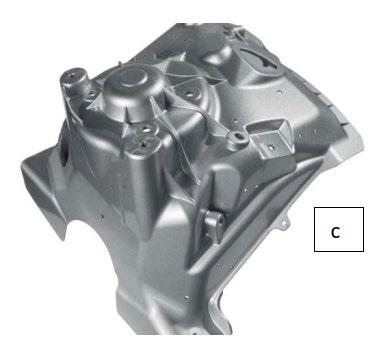
Fig.1 – (a) The rotating furnace-sonication system; (b) Impeller with nitrogen degassing, (c) Shock tower.
The quality of molten bath was measured via reduced pressure test (RPT) [7] and an image analyzer software examined several pictures (100×100 μm2) on RPT samples. The density (D) of each RPT specimen was measured by Archimedean method defined by the equation: D=Wa/(Wa −W w), where Wa and W w are the specimen’s weights in air and in water, respectively. Measurement of inclusions was carried out by PoDFA on 3 kg samples for each degassing method. Tensile tests were performed according to ISO 6892-1 A standard on sub-size specimens drawn from the castings at defined locations based on ASTM B557 M-15.
RESULTS AND DISCUSSION The RPT results and the comparison between the degassing methods are shown in Figure (2). As observed, both melts had a similar quality before degassing. The rotary vessel-ultrasound resulted in better degassing efficiency compared with the impeller+N2.
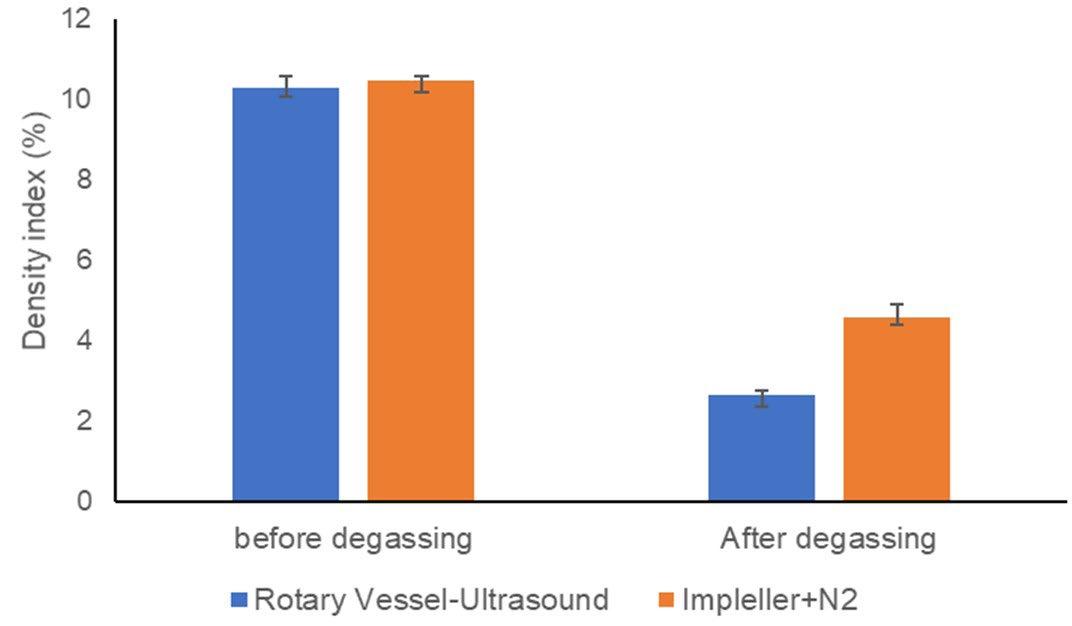
Fig.2 – Density index of molten metal before and after degassing with two different methods.
By rotary Vessel-Ultrasound, the density index decreased from 10.3% to 2.6% whereas by performing degassing with the impeller+N2, the value decreased from 10.5% to 4.6%. This indicates that rotary ultrasound has performed nearly 20% higher in degassing efficiency in comparison with the rotary impeller in one third of the time. It is known that in both impeller and ultrasonic techniques, cavitation degases and clean the melt. The reason of better degassing by ultrasound is based on the bubble density. An investigation by Eskin et al. [8] suggests a bubble density of 1 × 1011 m−3 with initial radii of 1 μm is produced by using a frequency of 17.7 kHz [8]. Such a high density of bubbles with increased surface area would improve the gas diffusion and further gas removal. The rotary system causes better spread of the bubbles throughout the melt to minimize shielding and attenuation effects where the frequency of 25 KHz is applied. In addition, in every acoustic cycle, the Bjerknes force attempts to bring the bubbles together whilst each of the bubbles creates a strong velocity field in the surrounding that gives rise to bubble spacing. These alternate attempts provide a steady state condition in which the distance between the bubbles remains nearly constant [9]. Therefore, more bubbles are available for hydrogen diffusion and further gas removal. Another reason of better degassing by ultrasonic is due to higher dross formation by impeller where the dross acts as an accumulator of hydrogen by adsorption of hydrogen molecules which is significant at above 600oC [10]. The dross level by rotary vessel-sonication system was 245 gr whereas for rotary impeller was 1300 gr. The rotary system competes with new design which was offered by ref [11] where 25% increment was observed on degassing efficiency.
Furthermore, the rotary vessel-ultrasound system could help for removal of the inclusions. By variation in the acoustic pressure, the cavitation bubbles are exploded and split into two smaller bubbles where a jet stream releases. The inclusions collide with the jet stream and the local variation of the acoustic pressure ruptures the oxide films and inclusions. Therefore, they are attached to the bubbles and float to the melt surface. Smaller bubbles with higher surface tension would contribute in removal of fine Al oxides. Kang et al. [12] has demonstrated the floatation rate of inclusions would increase by 6 times through the cavitation bubbles. Comparatively, the impeller by N2 process inclusion reduction is a win/lose process. The forced convection helps the agglomeration of the inclusions and their sedimentation whereas at the same time gas blow increases the probability of the attachment of inclusions to a bubble and its floatation. The PoDFA analysis (Figure 3) suggests the rotary vessel-ultrasonic method is more effective in comparison with impeller+N2 to remove inclusions. This could be attributed to the small velocity of forced convection in impeller system and poor wettability of inclusions. Nevertheless, in comparison with untreated melt the values have improved for impeller+N2. The significant amount of carbides is due to graphite impeller whereas for ultrasonic treatment the amount of carbon decreased to 0.09 mm2/kg. With respect to the initial content, the amount of aluminium oxides was decreased by 6 and 3 times by using ultrasonic treatment and impeller+N2, respectively.
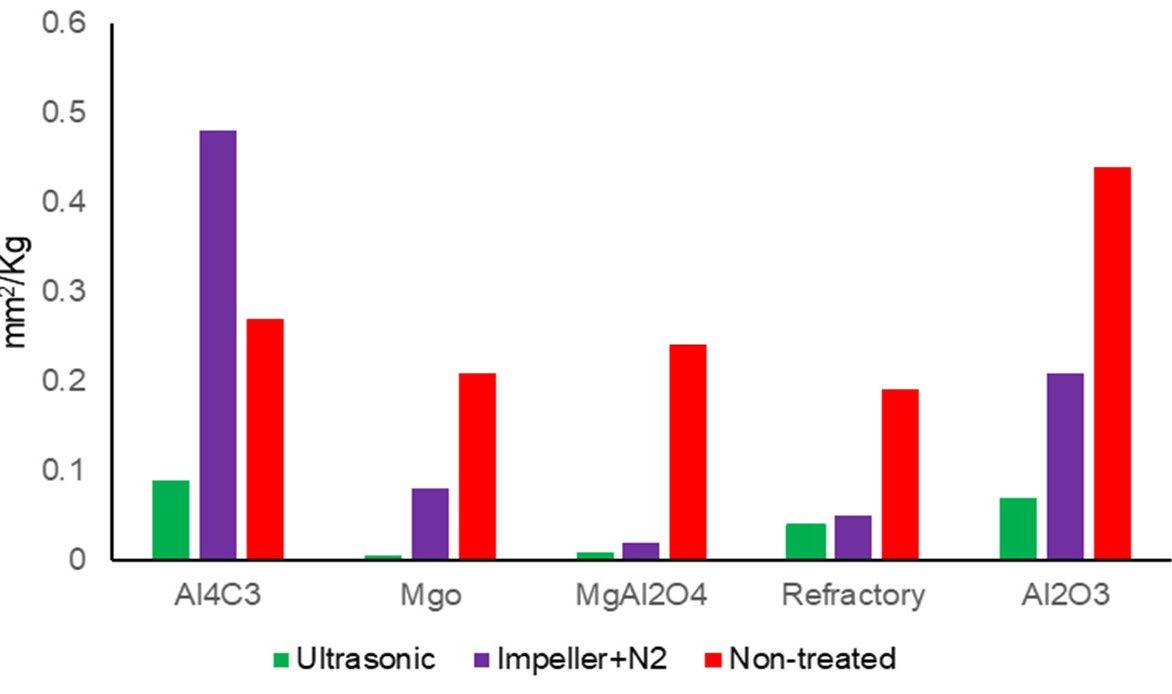
Fig.3 – PoDFA analysis of untreated, impeller+N2 and ultrasonically treated melts.
The microstructure of the diecast alloy at untreated, treated by impeller+N2 and rotary system is shown in Figure (4). More porosity are seen close to the intermetallic particles (e.g. Al15(Fe,Mn)3Si2). The β-phase particles are potential sites for porosity formation regardless of the alloy composition and the type or size of the β particles [13]. By application of rotary process, the intermetallic size has decreased considerably. The rotary vessel-ultrasonic system presented YS and UTS of 210 and 303 MPa and elevated elongation to 6% due to primary/eutectic Si refinement/modification as described in ref [14]. Impeller+N2 and untreated melt presented value of 180 and 165 for YS and 288 and 273 MPa for UTS, respectively. However, the elongation was not higher than 3% and 1% for impeller process and untreated melt, sequentially.
Fig.4 – Microstructure of diecast AlSi9Cu3(Fe) alloy: (a,b) untreated; degassed with (c,d) impeller+N2 and (e,f) rotary vessel-sonication.
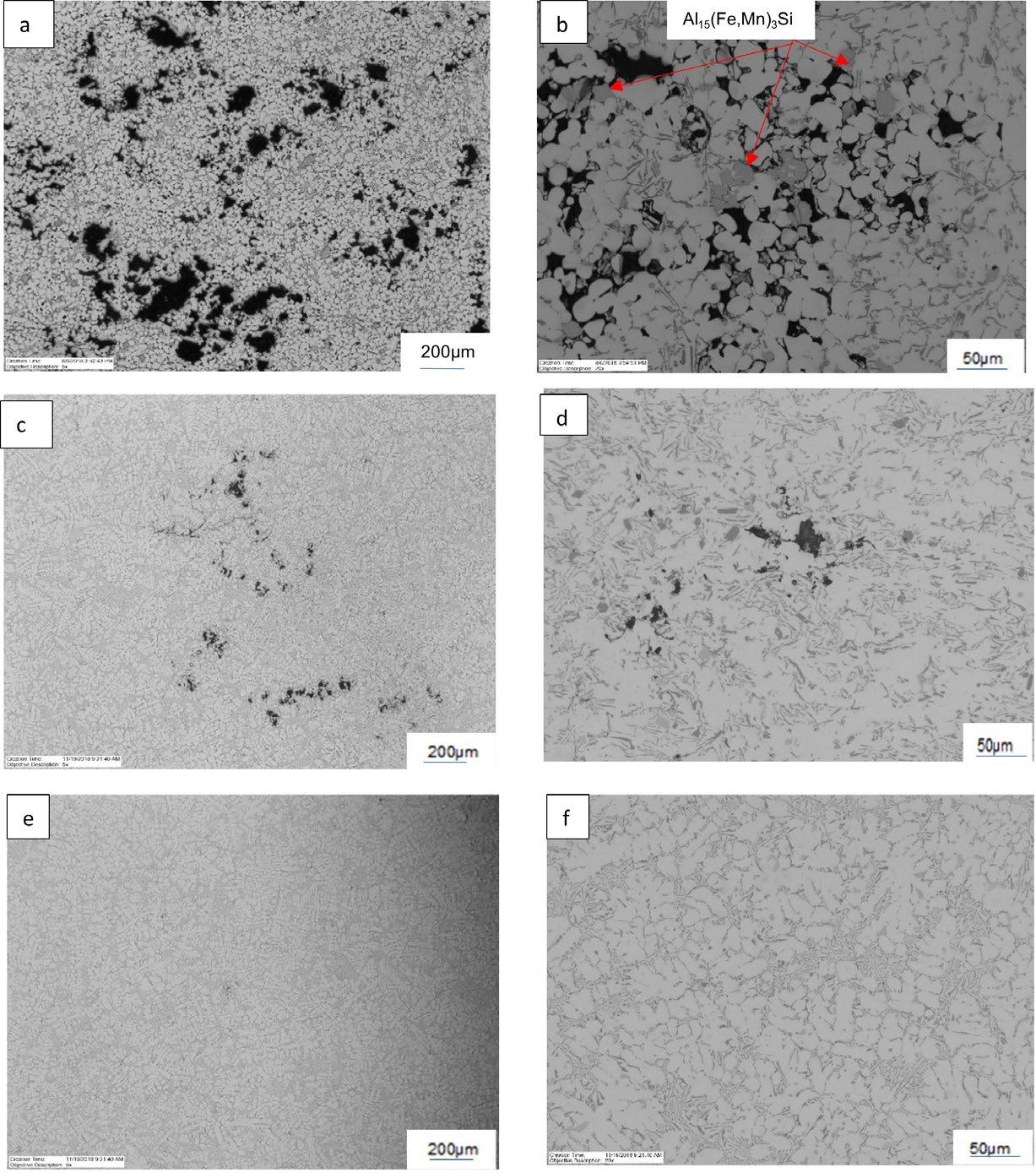
CONCLUSION A rotary sonication-ultrasonic technique was offered for degassing and inclusion removal. The results suggest 20% improvement for degassing and 2 times enhancement in oxide removal compared with impeller+N2. The YS, UTS and elongation was increased considerably. Moreover, 400 Kg of molten metal was treated whereas the maximum ever reported was 200 Kg. By the suggested technique the formation of undesired composition from the impeller decreases significantly and melt quality improves accordingly.
ACKNOWLEDGEMENT The authors appreciate George Fischer-Linamar company for their profound support.
REFERENCES
[1] Dinnis C.M, Taylor J.A, Dahle, A.K. Iron-related porosity in Al–Si–(Cu) foundry alloys. Mater. Sci. Eng. 2006; 425: 286-296. [2] Roy N., Samuel A.M. and Samuel F.H. Porosity formation in AI-9 Wt Pct Si-3 Wt Pct Cu alloy systems: Metallographic observations. Met Mater Trans A.1996; 27: 415-429. [3] Heiberg G., Nogita K., Dahle A.K., Arnberg L. Columnar to equiaxed transition of eutectic in hypoeutectic aluminium-silicon alloys. Acta Mater. 2002; 50:2537–46. [4] Haghayeghi R., Kapranos P. The Effect of Processing Parameters on Ultrasonic Degassing Efficiency. Mater Lett. 2014;116: 399-401. [5] Haghayeghi R., Heydari A., Kapranos P. Effect of ultrasonic vibrations prior to high pressure die-casting of AA7075. Mater Lett. 2015;153:175-8. [6] Lebon G.S.B, Abou-Jaoud G.S., Eskin D., Tzanakis I., Pericleous K., Jarry P. Numerical modelling of acoustic streaming during the ultrasonic melt treatment of direct-chill (DC) casting. Ultrason Sonochem. 2019; 54:171-182. [7] Samuel A.M., Samuel F.H. Various aspects involved in the production of low-hydrogen aluminium castings. J Mater Sci, 1992; 27: 6533–63 [8] Eskin D.G., Tzanakis I., Wang F., Lebon G.S.B, Subroto T., Pericleous K., Mi J. Fundamental studies of ultrasonic melt processing. Ultra Sonochem. 2019; 52:455-467. [9] Doinikov A.A., Translational motion of two interacting bubbles in a strong acoustic field. Phys. Rev. E, 64 (2001), Article 026301. [10] Eskin D., Alba-Baena N., Pabel T. and Da Silva M. Ultrasonic degassing of aluminium alloys: basic studies and practical implementation. Mater Sci Techno. 2015; 31: 79-84 [11] Eskin D.G, Al-Helal K., Tzanakis I. Application of a plate sonotrode to ultrasonic degassing of aluminum melt: Acoustic measurements and feasibility study. J. Mater. Process. Technol. 2015;222: 148-154. [12] Kang S., Shen M., Li C., Cold Model Experiments and Mechanism on Inclusion Removal by Ultrasonic Horn. Adv Mater Res, 2013; 750-752: 404-7. [13] Khalifa W., Samuel A.M., Samuel F.H., Doty H.W. & Valtierra S., Metallographic observations of β-AlFeSi phase and its role in porosity formation in Al–7%Si alloys. Int. J Cast Metal Res. 2006; 19:156-166. [14] Haghayeghi R., Depaula L.C, Zoqui E.J. Comparison of Si Refinement Efficiency of Electromagnetic Stirring and Ultrasonic Treatment for a Hypereutectic Al-Si Alloy. J Mater Eng Per. 2016; 29:1900-7.








